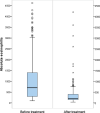Imported Mansonella perstans infection in Spain
- PMID: 32703283
- PMCID: PMC7376953
- DOI: 10.1186/s40249-020-00729-9
Imported Mansonella perstans infection in Spain
Abstract
Background: Mansonella perstans infection can be considered one of the most neglected tropical infectious diseases. Very few studies have reported on the clinical picture caused by infection with this nematode. Therefore, our study was aimed to describe the clinical patterns and treatment of imported M. perstans infection by migrants from Africa.
Methods: The present study evaluated a large cohort of migrants who have been diagnosed, examined and treated for imported M. perstans infection at a Spanish reference center (Hospital Carlos III Tropical Medicine Unit, Madrid, Spain) over a 19-year period. Most patients voluntarily attend the emergency unit or are referred from primary care or general hospitals in Madrid. Chi-square test was used to compare the association between categorical variables. The continuous variables were compared by Student's t-test or the Mann-Whitney test. The corresponding regression models were used for multivariate analysis.
Results: Five hundred three cases of migrants from tropical and subtropical areas with M. perstans infection were identified. Two hundred sixty-four patients were female (52.5%). The mean age (± SD) was 44.6 ± 18.2 years (range: 16-93 years). The mean time (± SD) between the arrival in Spain and the first consultation was 8.6 ± 18.0 months. The major origin of the patients was Equatorial Guinea (97.6%). Regarding the clinical picture, 257 patients were asymptomatic (54.7%) and 228 were symptomatic (45.3%); 190 patients had pruritus (37.8%), 50 (9.9%) had arthralgia, 18 patients had Calabar-like swelling (3.6%), and 15 (3%) had abdominal pain. Four hundred forty-two (87.9%) migrants had hyper-IgE, and 340 (67.6%) had eosinophilia. One hundred ninety-five patients had coinfections with other filarial nematodes (38.8%), and 308 migrants had only M. perstans infection (61.2%). Four hundred thirty-seven cases (86.9%) had been treated with anti-filarial drugs; 292 cases were treated with one anti-filarial drug, and 145 cases were treated with combined anti-filarial therapy. Additionally, 20 (4%) cases received steroids and 38 (7.6%) cases received antihistamines.
Conclusions: A long series of M. perstans infections is presented in sub-Saharan immigrants whose data indicate that it should be included in the differential diagnosis in patients with pruritus or analytical alterations such as eosinophilia or hyper-IgE presentation, and they also have a high number of coinfections with other microorganisms whose treatment needs to be protocolized.
Keywords: Clinical study; Immigrant; Imported diseases; Mansonella perstans; Mansonellosis; Spain.
Conflict of interest statement
All authors declare no potential conflicts of interest and no sources of support.
Figures
References
-
- Simonsen PE, Onapa AW, Asio SM. Mansonella perstans filariasis in Africa. Acta Trop. 2011;120(Suppl 1):S109–20. - PubMed
-
- Bregani ER, Rovellini A, Mbaïdoum N, Magnini MG. Comparison of different anthelminthic drug regimens against Mansonella perstans filariasis. Trans R Soc Trop Med Hyg. 2006;100:458–63. - PubMed
-
- Asio SM, Simonsen PE, Onapa AW. Analysis of the 24-h microfilarial periodicity of Mansonella perstans. Parasitol Res. 2009;104:945–8. - PubMed
Publication types
MeSH terms
Substances
LinkOut - more resources
Full Text Sources
Medical


